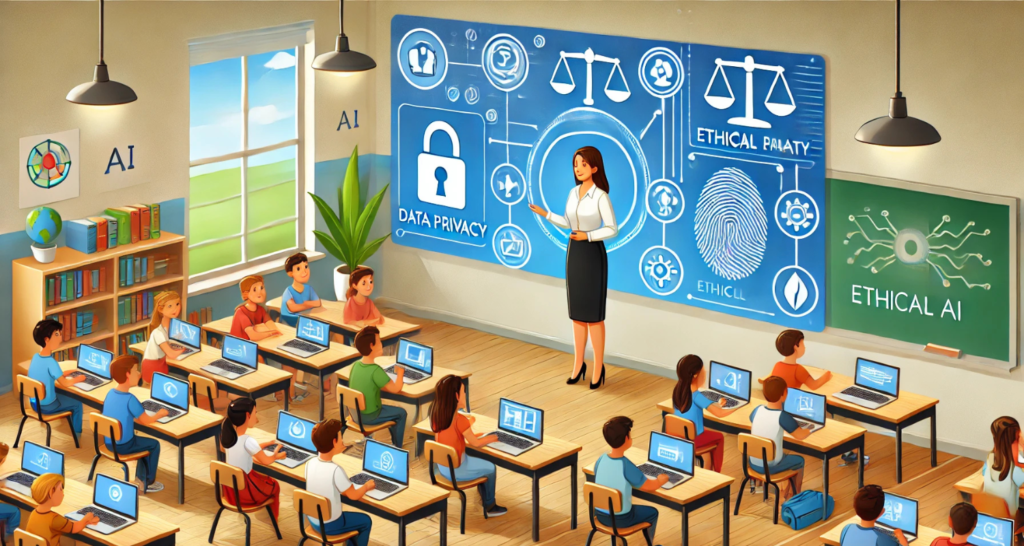
The use of AI in classrooms has been quite exciting but has also brought extremely important questions regarding data privacy, security, and ethical issues. So let’s get into this stuff to understand how educators can be able to incorporate AI responsibly while ensuring rights and privacy for students.
1. The Benefits of AI in Education
AI has the potential to change the face of education through personalization of learning, automating routine tasks, and providing deeper data-driven insights on student performance. Adaptive learning platforms, intelligent tutoring systems, and AI-assisted grading are just some of the applications that can really help teachers save time and better meet the students’ individual needs. However, for these benefits to be meaningful, AI systems have to access serious student data—that raises a lot of privacy concerns and ethical issues.
2. Data Privacy Risks with AI
AI is typically based on huge data collection, including personal information of students, their learning progress, behavioral patterns, and sometimes even biometric data. The key concerns are:
- Data Collection and Storage: Schools must store students’ data in a secure manner. However, third-party providers can be problematic for that. This might result in unauthorized access or data breaches if the AI systems fail to store data appropriately.
- Data Misuse: There is a potential that the AI companies might have access to sensitive information about the students. It gives rise to questions regarding data ownership and data misuse in advertising or other commercial applications.
- Lack of transparency: In most cases, educators and parents do not clearly understand how the AI algorithms process and analyze data. Lack of transparency would make it very hard to find out what is done with the information about students, who has access to it, and how long it is stored.
3. Legal Protections for Student Data
Countries are coming into action with laws and regulations on safeguarding students’ private data, including:
- FERPA (Family Educational Rights and Privacy Act) in the United States: Protects who has access to student data and under what conditions, giving parents rights over their children’s educational information.
- General Data Protection Regulation (GDPR) of the European Union: Though not a law specific to education, it has very strict norms concerning data protection and thus has consequences for institutions and ed-tech providers operating in Europe.
- COPPA: The U.S. law protect children’s online privacy and restricts data collection from children under 13 years, besides compelling a parent/guardian to give consent before using data.
Educators should ensure that the AI tool adapted reduces risks around data by being compliant with the appropriate laws.
4. The Ethical Issues of AI in the Classrooms
Apart from issues of privacy, ethical issues concern fairness, inclusion, and accountability:
- Bias in Algorithms: AI algorithms show unconscious biases related to race, gender, socio-economic status, and learning disabilities, hence leading to unfair treatment of some groups of students.
- Impact on Student Autonomy: Excessive dependence on AI systems might decrease the degree of independent decision-making by students. For instance, if an AI recommends learning paths to a student, it may reduce the choices that the student can make.
- Surveillance Concerns: Some AI tools might surveil students’ behaviors and actions closely; it could become intrusive. Useful oversight should be balanced with respect for the privacy of the students.
Responsible Implementation of AI in Education
To ensure that AI enhances education while respecting students’ rights, schools and educators can:
- Choose Transparent AI Tools: Select only those vendors which are open about the usage of data, design of algorithms, and data retention policies.
- Engage Parents and Students: Engage both parents and students in dialogue about the AI tools used; make them understand the benefits and risks.
- Data-minimization in data collection: IEEE-RPP only collect data that are absolutely required for the educational purpose; otherwise, minimize collection of data to reduce risks.
- Ensure Teacher Oversight: While AI can automate tasks, teachers should have the final say in any decision impacting the students, especially in the assessment and grading light.
5. The Future of AI in Education: Striking a Balance
AI in education is here to stay, and it holds transformative potential. But the key for educators and policymakers is to find a balance between innovation in technology and the defense of the rights of students. Ensuring data privacy, working within ethical guidelines, and making decisions about AI use that involve all stakeholders will be crucial to ensuring that this learning environment is safe, fair, and supportive.
7. Advanced Data Privacy Concerns: Beyond the Basics
- Profiling and Long-Term Data Impact: AI can create detailed profiles of students’ learning styles, behaviors, and performance over time. While this information can support personalized learning, it also poses risks if used improperly. There’s a risk of “profiling bias,” where a student’s past performance could unfairly shape future opportunities, and if not handled carefully, profiling could hinder a student’s growth by focusing too narrowly on certain data patterns.
- Third-Party Data Sharing: Schools often rely on third-party vendors for AI solutions, and data-sharing agreements with these vendors are crucial. Schools need to be clear about data ownership and access rights in these agreements, as well as any clauses related to the resale or use of student data beyond educational purposes.
- Data Storage and Deletion Policies: Schools and vendors must establish clear policies regarding how long student data is stored and when it is deleted. Retaining data beyond its necessary use increases risks of breaches and misuse. For example, does the data automatically delete upon a student’s graduation? Educators should look for AI tools with well-defined retention and deletion policies.
8. Types of AI Tools in the Classroom and Their Implications
Different types of AI applications in education bring unique privacy and ethical considerations. Here are a few common types:
- Adaptive Learning Platforms: These platforms adjust educational content to a student’s level, allowing for individualized learning experiences. While powerful, adaptive systems continuously gather data on students’ progress, often using predictive analytics to suggest the next steps. Schools should ensure these systems are fully transparent and explain how recommendations are made.
- Proctoring Software: AI-driven proctoring tools monitor students during exams, using webcam and audio data to detect suspicious behavior. However, concerns about constant surveillance, data security, and accuracy of these tools raise ethical questions. False positives could unfairly penalize students, and the surveillance aspect can be seen as an invasion of privacy.
- Sentiment Analysis Tools: These tools analyze students’ written or spoken language to gauge emotional states. While they can help teachers identify students needing extra support, they can also infringe on students’ privacy and introduce biases in interpretation. For instance, a tool might inaccurately interpret a student’s behavior based on cultural differences in expression.
9. Data Security Measures to Safeguard Student Information
Data security is fundamental when using AI tools in schools. Effective security strategies include:
- Encryption and Secure Access: Any stored student data should be encrypted, and access should be limited to authorized personnel only. Multi-factor authentication (MFA) is another effective measure to secure access to sensitive information.
- Regular Audits and Penetration Testing: Schools and vendors should conduct regular security audits and penetration tests to identify vulnerabilities. These tests simulate hacking attempts to assess whether data protection measures are adequate.
- Training for Educators and Administrators: Often, data breaches occur due to human error. By training teachers and administrators on data security best practices, schools can reduce risks. Training should include information on secure data handling, recognizing phishing attempts, and adhering to privacy policies.
10. Ethical Responsibilities of Stakeholders
Ethical AI implementation in education involves the responsibilities of multiple stakeholders, including schools, AI vendors, policymakers, and parents.
- Schools and Educators: Schools must ensure that the chosen AI tools comply with ethical guidelines, protect student data, and are used fairly. Educators play a critical role in monitoring AI outputs, avoiding over-reliance on automated recommendations, and being transparent with students and parents about AI usage.
- AI Vendors: Vendors providing educational AI solutions have a responsibility to design fair, unbiased algorithms and to make data protection a priority. They should be transparent with schools about how their algorithms work and provide options for customization to fit each school’s privacy needs.
- Policymakers: Government bodies need to establish clear guidelines for AI usage in education, setting standards for data privacy, ethical use, and accountability. They should work toward stronger enforcement of privacy regulations and oversight of AI tools to protect students’ rights.
- Parents and Students: Parents and older students should be informed about their data rights and the role of AI in the classroom. Schools can facilitate this by holding information sessions and offering resources that explain how AI tools work and the data privacy measures in place.
11. Mitigating Bias and Ensuring Fairness in AI
Bias in AI algorithms can lead to unfair outcomes in educational settings. Some strategies to address this include:
- Diverse Data Training: AI models should be trained on diverse datasets to avoid biases related to race, gender, or socioeconomic background. Vendors and researchers should ensure that AI is tested across different groups to reduce disparities in predictions or recommendations.
- Regular Audits for Algorithm Fairness: Schools and vendors should conduct periodic audits to evaluate how AI tools impact different student groups. For example, examining how well the tool performs for students with learning disabilities or those from different cultural backgrounds can reveal potential biases.
- Human Oversight in Decision-Making: AI should not replace teachers’ judgment but rather serve as an aid. Teachers should be the final decision-makers, especially in cases like grading, behavioral assessments, or personalized learning plans. This helps mitigate potential biases and ensures that AI is used to support rather than dictate educational outcomes.
12. Navigating the Future of AI in Education
AI will continue to evolve, bringing new possibilities and challenges for education. As schools increasingly adopt AI, here are some considerations for its ethical evolution:
- Student Involvement in AI Policy Creation: Involving students in discussions about AI policies can empower them to understand their data rights and how AI impacts their education. Schools can create student advisory panels that review AI-related policies.
- Promoting Digital Literacy: As AI becomes a core part of education, teaching digital literacy, including data privacy awareness and ethical considerations, can prepare students to engage responsibly with technology in the future.
- Collaborative Efforts for Safe AI: Collaborative efforts among schools, vendors, policymakers, and researchers can lead to safer, more transparent, and fairer AI in education. This could include establishing industry standards or creating shared resources on ethical AI practices for schools.
FAQs
Q: What should teachers look for in AI-powered educational tools?
Teachers will want to look for transparency in the data policies, adherence to privacy laws, and features that will enable them to control the interpretation of AI-driven insights instead of just relying on automated decisions.
Q: Can AI in education help reduce the workload of teachers?
Yes, AI can facilitate grading, provide tailored resources, and even recommend personalized interventions. Still, the tools should supplement, not replace, teacher judgment. Q: How might schools ensure the ethical use of AI? Schools can adopt policies that foreground data privacy, reduce bias, and emphasize educational goals. It is important to collaborate with vendors who abide by the regulations of privacy and are transparent and ethical in their AI tools.
Q: Is AI safe to be used with young children?
AI can be made safe for young learners, provided it is used thoughtfully. It could reduce potential risks through data minimization, transparency, and involvement of parents.

